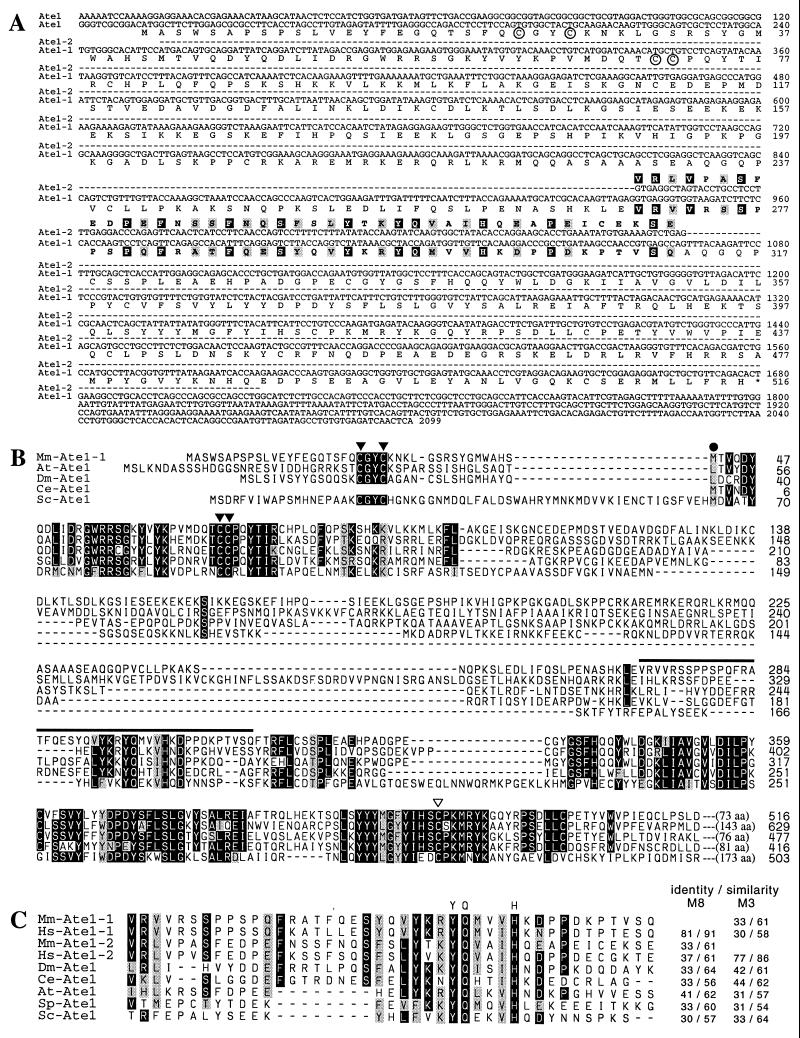FIG. 2.
Two forms of the mouse Ate1 cDNA and the ATE protein family. (A) The mouse Ate1-1 and Ate1-2 cDNAs and their products. The nucleotide sequences of Ate1-2 identical to those of Ate1-1 (everywhere except for the 129-bp region) are indicated by dashes. In the region of the alternative 129-bp exons of Ate1-1 and Ate1-2, white-on-black and gray shadings highlight, respectively, identical and similar residues. The circled Cys residues are homologous to those that are important for the enzymatic activity of S. cerevisiae Ate1p (32). (B) The ATE protein family and the origins of the alternative 129-bp exons. Alignment of the sequences of mouse ATE1-1p (Mm-Ate1-1), A. thaliana Ate1p (At-Ate1), D. melanogaster Ate1p (Dm-Ate1), C. elegans Ate1p (Ce-Ate1), and S. cerevisiae Ate1p (Sc-Ate1) (accession no. J05404). Similar residues (gray) were grouped as follows: M, L, I, and V; D, E, N, and Q; R, K, and H; Y, F, and W; S, A, and T. The region encoded by the alternative 129-bp exons of mouse Ate1 is highlighted by a thick line. Of the Cys residues that are conserved among all ATE proteins, the ones required and not required for the enzymatic activity of S. cerevisiae Ate1p (32) are indicated, respectively, by ▾ and ▿. The N-terminally truncated mouse ATE1-1p and ATE1-2p proteins which began at Met-42 (•) lacked the R-transferase activity (data not shown). The highly variable C-terminal regions of ATE proteins were omitted from the alignment. The sequences were aligned using PileUp program (Wisconsin Package; Genetics Computer Group, Madison, Wis.). Gaps (−) were introduced to optimize the alignment. The residue numbers are on the right of the sequences. The sequence of C. elegans Ate1p appears to lack the N-terminal region of other ATE proteins because of an error in defining the Ate1 ORF in the genomic DNA sequence (accession no. Z21146). (C) Alignment of the 43-residue regions that are encoded by the alternative 129-bp exons in mammalian Ate1. Sequences shown: mouse (Mm-Ate1-1 and Mm-Ate1-2), human (Hs-Ate1-1 and Hs-Ate1-2), D. melanogaster (Dm-Ate1), C. elegans (Ce-Ate1), A. thaliana (At-Ate1), S. pombe (Sp-Ate1; accession no. Z99568), and S. cerevisiae (Sc-Ate1) (accession no. J05404). The degrees of identity and similarity of ATE proteins to the deduced amino acid sequences of the M8 (mouse ATE1-1p) or M3 (mouse ATE1-2p) exon of the mouse Ate1 gene are indicated on the right. The residues conserved among all of the compared sequences are indicated above the alignment.

